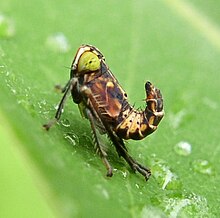Auchenorrhyncha
| Auchenorrhyncha | |
|---|---|

| |
| Red-banded leafhopper, Graphocephala coccinea | |
| Scientific classification | |
| Domain: | Eukaryota |
| Kingdom: | Animalia |
| Phylum: | Arthropoda |
| Class: | Insecta |
| Order: | Hemiptera |
| Suborder: | Auchenorrhyncha |
| Infraorders | |
The Auchenorrhyncha suborder of the Hemiptera contains most of the familiar members of what was called the "Homoptera" – groups such as cicadas, leafhoppers, treehoppers, planthoppers, and spittlebugs. The aphids and scale insects are the other well-known "Homoptera", and they are in the suborder Sternorrhyncha.
Distributed worldwide, all members of this group are plant-feeders, and many are vectors of viral and fungal diseases of plants.
It is also common for Auchenorrhyncha species to produce either audible sounds or substrate vibrations as a form of communication. Such calls range from vibrations inaudible to humans, to the calls of many species of cicadas that can be heard for hundreds of metres, at least. In season, they produce the most characteristic and ubiquitous noise of the bush.
Etymology
The word "Auchenorrhyncha" is from the Greek αὐχήν, 'neck, throat' and ῥύγχος, 'snout'.[citation needed]
Classification



Debate and uncertainty as to whether the Auchenorrhyncha is a monophyletic group or not is ongoing; some authors, believing it was not, split it into two suborders, the Clypeorrhyncha (= Cicadomorpha) and the Archaeorrhyncha (= Fulgoromorpha).[1] In the last 10 years, there has been evidence to support the monophyletic interpretation, and the most recent research indicates the Auchenorrhyncha are in fact a monophyletic lineage.[2] A classification of the Auchenorrhyncha is:[3]
- Infraorder Cicadomorpha (Clypeorrhyncha, Clypeata)
- Superfamily Cercopoidea (spittlebugs, froghoppers)
- Superfamily Cicadoidea (cicadas)
- Cicadidae (Platypediidae, Plautillidae, Tettigadidae, Tibicinidae)
- Tettigarctidae (hairy cicadas)
- Superfamily Membracoidea (Cicadelloidea)
- Aetalionidae (Biturritiidae)
- Cicadellidae (Eurymelidae, Hylicidae, Ledridae, Ulopidae, leafhoppers)
- Melizoderidae
- Membracidae (Nicomiidae, treehoppers)
- Myerslopiidae (Cicadellidae, in part)
- Infraorder Fulgoromorpha (Archaeorrhyncha, planthoppers)
Notes
- ^ Sorensen J.T.; Campbell B.C.; Gill R.J.; Steffen-Campbell J.D. (1995). "Non-monophyly of Auchenorrhyncha ("Homoptera"), based upon 18S rDNA phylogeny: eco-evolutionary and cladistic implications with pre-Heteropteroidea Hemiptera (s.l.) and a proposal for new monophyletic suborders". Pan-Pacific Entomologist. 71 (1): 31–60.
- ^ Cryan J.R.; Urban J.M. (2012). "Higher-level phylogeny of the insect order Hemiptera: is Auchenorrhyncha really paraphyletic?". Systematic Entomology. 37 (1): 7–21. doi:10.1111/j.1365-3113.2011.00611.x.
- ^ C. H. Dietrich in Resh, V. H. & Carde, R. T. (Eds.) 2003 Encyclopedia of Insects. Academic Press ISBN 0123741440.
External links
- World Auchenorrhyncha Database
- Bibliography of the Auchenorrhyncha of Central Europe
- DrMetcalf: a resource on cicadas, leafhoppers, planthoppers, spittlebugs, and treehoppers
- Photographic Atlas of the Planthoppers and Leafhoppers of Germany Archived 2021-02-16 at the Wayback Machine
- Photographs of the Auchenorrhyncha of North and South America
